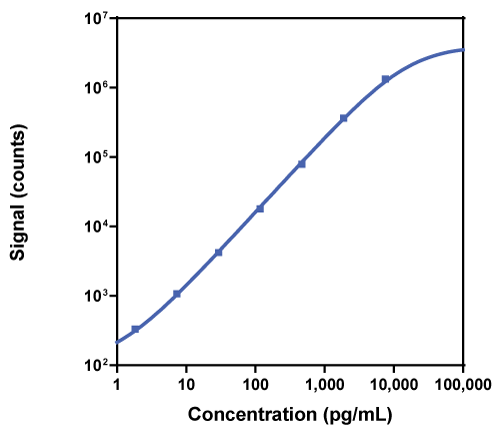Please note: This analyte is also sold as a U-PLEX assay.
Click here to be directed to the U-PLEX assay page. MSD is continuing to sell this R-PLEX Antibody Set until inventory is depleted. If you want to order the R-PLEX Antibody Set, you can choose to purchase it from this page.
R-PLEX Human GIP (total) Antibody Set Overview The R-PLEX Human GIP (total) Antibody Set includes a matched capture and detection antibody pair and calibrator for the quick and easy measurement of GIP (total) in biological samples. R-PLEX products leverage MSD’s electrochemiluminescence technology for better sensitivity and a larger dynamic range than traditional ELISAs. R-PLEX matched antibody sets enable the development of singleplex and multiplex immunoassays. Individual assays may be developed using MSD avidin- or streptavidin-coated plates. Custom multiplex assays with any combination of R-PLEX analytes, as well as R-PLEX plus U-PLEX analytes, can be developed on U-PLEX MULTI-SPOT plates. To learn more about the advantages of R-PLEX products
click here.
R-PLEX Human GIP (total) Antibody Set Features - Measures human GIP (total) in serum and plasma
- Dynamic range: 4.8 - 6,500 pg/mL
- Median LLOD: 4.8 pg/mL
- Can be used to develop individual analyte assays as well as multiplex panels
Typical Data Calibration curve for the R-PLEX Human GIP (total) Antibody Set was assessed and representative data are presented below
Figure 1. R-PLEX Human GIP (total) Antibody Set Calibration Curve 
GIP (total) Analyte
Description - Gastric Inhibitory Polypeptide (GIP, Glucose-dependent Insulinotropic Polypeptide, incretin) is synthesized by enteroendocrine K cells and is secreted into plasma in response to nutrient flow. GIP binds to G-protein coupled receptors in many tissues. GIP protects the small intestine from acid damage and induces insulin secretion. It has been reported that Type 2 diabetics are resistant to GIP. The GIP (total) assay recognizes both the active (1-42) and inactive (3-42) forms of GIP.
Disease Research Area - Metabolic Diseases
Application Area - Metabolic
-
Recommended Components
-
Specifications
-
-
Documentation
-
References
Why do I need other components
Catalog No.
Product Name
Size
R50JA-4
R50AA-4
R60AM-1
L45SA-1
|
Application(s)
|
|
Metabolic
|
|
|
Analyte(s)
|
|
GIP (total)
|
|
|
Species
|
|
Human
|
|
|
Capture Antibody
|
|
Mouse Monoclonal
|
|
|
Detection Antibody
|
|
Mouse Monoclonal
|
|
|
LLOD (Sensitivity)
|
|
4.8 pg/mL
|
|
|
Dynamic Range
|
|
4.8 - 6,500 pg/mL
|
|
|
Sample Type
|
|
Serum, Plasma
|
|
|
Usage Statement
|
|
For Research Use Only. Not for use in diagnostic procedures.
|
|
|
Storage Statement(s)
|
|
Please refer to the product insert for the storage conditions of individual kit components.
|
|
|
Storage Condition
|
|
Multi-Component
|
|
|
Gene ID(s)
|
|
2695
|
|
|
UniProt ID(s)
|
|
P09681
|
|
|
Assay Diluent(s)
|
|
Diluent 13
|
|
|
Antibody Diluent(s)
|
|
Diluent 12
|
|
|
Product Inserts
|
|
|
|
Datasheets
|
|
|
|
Handouts
|
|
|
|
SDS
|
|
|
|
Title
|
Journal
|
Year
|
|
Impact of intestinal electrical stimulation on nutrient-induced GLP-1 secretion in vivo.
|
|
|

|
Roux-en-Y gastric bypass surgery but not vertical sleeve gastrectomy decreases bone mass in male rats.
|
|
|

|
|
|
Customer Service/Orders
Scientific/Technical Support
Instrument Support
Company Headquarters